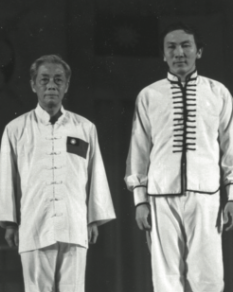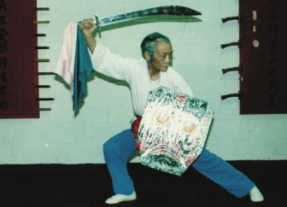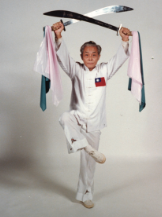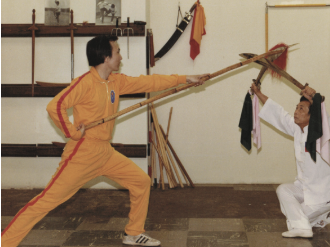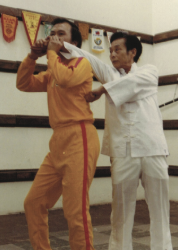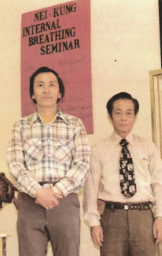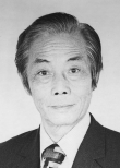
- Supreme Master, 63rd Generation Tien Shan Pai
- “Double Broadsword King” of China (雙刀王)
- Member, First Professor/Research Class of Central Kuo Shu Academy (中央國術館)
Huang, Chien-Liang recounts:
In 1967, I started studying martial arts with Supreme Master Wang Chueh-Jen. I liked the looks of the northern style Tien Shan Pai. Not only was it very good for self-defense, it was also a beautiful style and had health benefits. When my Shi Ye was young, he had many teachers. His father was agood martial artist and a wealthy man, so my teacher’s father hired the best instructors. His father could tell who were good martial arts teachers and who were not. Of these, my Shi Ye selected five of his favorite teachers to stay at his house for a long time.
Of the martial arts styles, he liked Tien Shan Pai the most. The form is pretty and practical. Tien Shan Pai has a good training system, especially at the higher levels. Then you can study Drunken Style, advanced Qin Na, Iron Palm, Dragon Grass Pole techniques, advanced Nei Gong, and advanced martial
Qi Gong.
The Zhong Yang Kuo Shu Guan was established in 1928. Supreme Master Wang was in the professor-research class, the first annual class. He trained to be a teacher, but since this was the first class, they also helped design the programs used for all successive classes. He brought Tien Shan Pai to the east coast of China. Later, he brought Tien Shan Pai to Taiwan.
Supreme Master Wang trained special agents for the Republic of China during the war. He had to leave when the communists took over because he worked for the former government. When he worked for the government, he taught a lot of self- defense skills to these agents. From this he developed the radar style of fighting.
He put his martial arts experience together to train the armed forces. He was too short to be in the army, but because he had so much skill in martial arts he was hired to teach martial arts. Supreme Master Wang established himself first in China, and then he moved to Taiwan. This was the old way. So many masters in China worked very hard, but only a few were very successful.
Supreme Master Wang first visited the United States in 1981. He stayed in the U.S. for six months, visiting Cincinnati, Maryland, and the Washington, D.C. area. During this time, Supreme Master Wang instructed me and my students. My Shi Ye returned to the U.S. in the fall of 1982 and stayed four months until spring 1983. He visited a third time in the fall of 1985 until the spring of 1986.
Supreme Master Huang’s Only Formal Disciple
During the visit in 1985, Supreme Master Wang explained to Huang, Chien-Liang that he was his only formal disciple, as Huang was the only student to complete the full, formal ceremony of discipleship. This showed the trust that Wang
had placed in Huang, as well as his plans to establish him as successor and lineage holder of Tien Shan Pai.
In traditional Chinese martial arts, there is a difference between students and disciples. Both learn from the teacher, but the relationship a disciple has with their teacher is much deeper.
When a student is accepted as a disciple, it means the teacher has officially recognized the student as part of the family and that student has the opportunity to learn the secrets of the art.
As for the disciple, the teacher is regarded with utmost loyalty, respect, and deference. The disciple also has more responsibilities to their teacher and are expected to support their teacher in every way possible as they help pass on the art.

